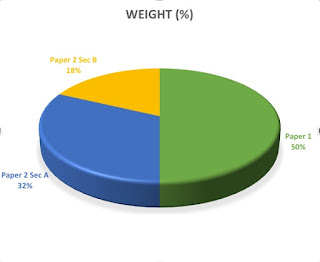PREPARING FOR PAPER 1
The first paper is popular for being tricky and many candidates confirm they don't finish attempting questions within stipulated time. Today I will focus on how to prepare for the first paper and ways to perform better.
In one of the posts I wrote last year on my blog zimtuts.blogspot.com I highlighted how the first paper is designed to 'steal' your time and the biase of mark distribution. I will highlight new tricks in the next posts on paper 1.
# Tested concepts #
Paper 1 tests almost 90% of the syllabus in 25 - 30 questions. The syllabus specifies that the paper tests all the concepts. There is need to check the whole syllabus sections and compare with the textbook topics to see if it's covering the whole syllabus.
The basic topics tested in the beginning of the paper [question 1 - 13] involves
- Prime Factors
- Type of numbers
- Square roots
- Fractions and decimals
- Volume, density and mass
- Unit conversions
- Time
- Limit of accuracy
- Approximations and estimations
- Scale and map problems
- Similarity
Among other basic topics
Using New General Mathematics Book 3 and 4? Check if these basic topics are covered.
# How to Prepare for the Paper #
One of the reasons why candidates fail is they assume maths is all about complex questions and waste much of their time of optional topics like Cosine rule, transformation or Mensuration.
First start to master basic concepts. The first step in Maths is to know the operands and how they apply to every situation.
Try to master the following
- multiples (time - table or Multiples of 1 to 12)
- Factors of numbers up to 100
- Types of numbers
- Directed numbers
- Rounding numbers
- Addition and subtraction of time
- Formulas for areas and other basic calculations
- Conversions of units
You will find that most don't finish the paper because they fail to quickly calculate say 9 x 13, or 11 x 12. Someone scribble the whole answer space to calculate these types of basic multiplication.
It might sound fun but it's worth to start by mastering that multiple table at the back of the exercise books. Learn to memorize it by head. If possible expand it up to the multiples of 15 or 20. It will make your life easier in the next topics
The disadvantages of using Book 3 is that you miss most of the concepts covered in Book 1 and 2. It's advisable to first learn those basics before you start to use book 3.
Most teachers expect you to have covers majority of these topics at primary level or Junior Level. If you were not paying attention or did not cover the topics due to various reasons, consider revisiting the principles on your own time and learn the basic rules of numbers.
# What makes Prime Factors Important #
Finding Prime Factors of numbers is important since it helps you in many concepts including but not limited to
- finding roots
- Multiples
- Factors
- HCF and LCM
- Factorization
- Indices
Master how to express a number as product of its prime factors. It will save your life in many principles.
NB: Do you want to learn these basic principles? Ask for FREE video lessons on basic numbers on


























